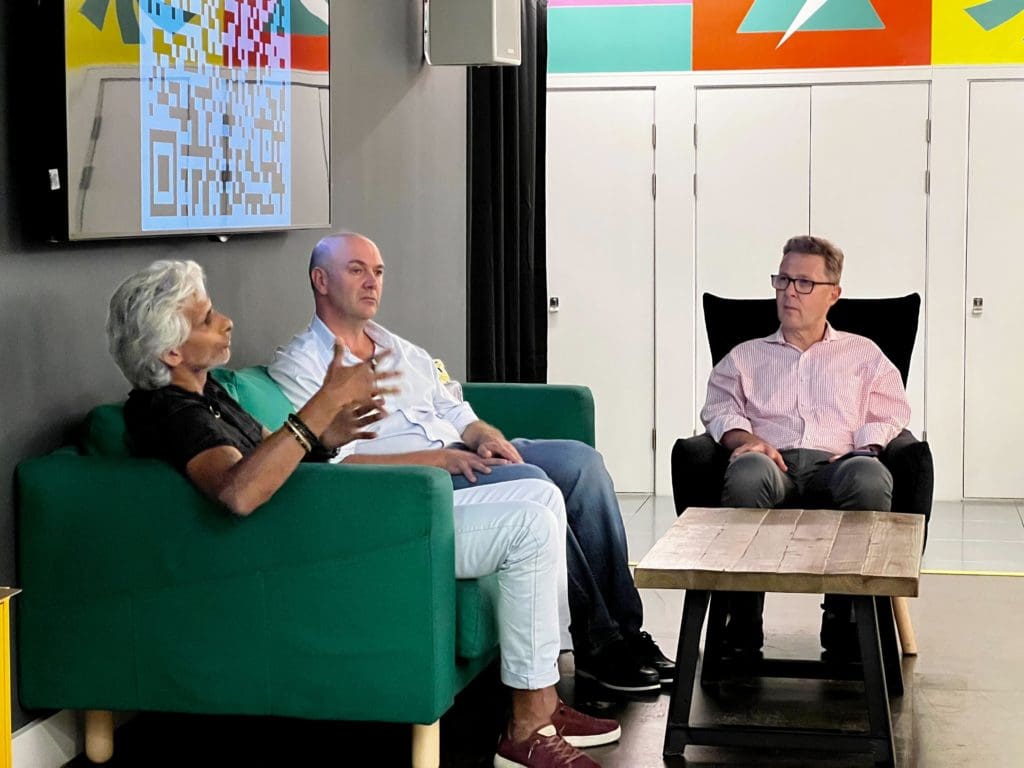Interbank payment is an area filled with issues. With clunky processes and long transaction times, businesses are turning to the development of new technology which can facilitate easier transactions.
A solution that could significantly disrupt this sector was discussed in depth at Fintech Nexus’ meet-up in London yesterday, with speakers Rhomaios Ram, CEO of Fnality, and Julio Faura, CEO of Adhara, joining Peter Renton on stage.

Adhara and Fnality worked together to tackle issues in financial market infrastructure (FMI), creating a solution using blockchain and distributed ledger technology (DLT). Initially, a research project exploring how DLT could affect financial markets, the initiative grew to include a consortium of financial institutions, eventually forming the Utility Settlement Coin (USC) Project.
“There was a small handful of banks in 2016 that realized it’s all very well to put, for example, equities on a blockchain, but you’re still going to end up with a lot of the operational problems that you wouldn’t otherwise have, if you don’t have the payment part of it, also on the chain,” said Ram.
“We’re creating what’s known as a Synthetic Central Bank Digital Currency; basically the ultimate stablecoin as a central bank backs it. We’re creating the world’s first institutional blockchain-based payment system. And of course, the core innovation is that it has a critical view of central bank money.”
“If you’re going to support wholesale capital markets, you’ve got to settle in central bank money. If you use private money, you’re at risk that that private institution will fail. So if you pay in a stablecoin issued by Circle, there’s always a problem that Circle, even if it’s a remote possibility, could go bankrupt. People can’t afford to take that risk when money’s lost and when you’re talking about settling transactions with hundreds of millions.”
Achieving the credit quality of a central bank
Ram explained that the critical challenge of the development was creating the credit quality of a central bank. The Bank of England’s Omnibus Account was pivotal to achieving this.
“The Omnibus account is an account where, like a joint account, everyone puts their money into it, and the money sits there. So what we do with the blockchain is effectively use that as an accounting system that determines the ownership of the funds inside that account.”
“Then you can transfer money using a blockchain as normal, but the funds stay sitting in this account, but ownership transfers to another group. And that’s how we achieve the credit quality of a central bank because money is all sitting at the Central Bank in this one account, but the owners are transferring money between each other.”
The project’s focus is wholesale transactions between financial institutions, creating a need for credit monitoring. They established that fundamentally, the project builds on top of how private stablecoins work. The added layer of trust and security from using the account within the central bank created a perfect environment for transactions between banks.
“Tokens are representations of claims to ownership,” added Faura. “The real success is ensuring that these asset stakes have credibility.”
“The banks are so interested in this because it solves a whole bunch of possible operational problems,” said Ram. “We also saw the massive liquidity problem for them. So right now they have their money spread across many different institutions, and there’s a big, multi-billion dollar problem the bank around liquidity usage.” The switch from two-day settlement to real-time settlement solves this liquidity issue.

Interoperability drives design
With interoperability at its core, the USC Project has focused on creating a solution available in multiple currencies, offering opportunities to develop an on-chain basis for central banks worldwide. Ram explained that each country would work on its jurisdictional blockchain to adhere to local regulations. Although the solution released in October 2022 would start in England, it would soon roll out to Europe and America.
In addition, the USC operates across multiple business platforms, whether to support PvP or DvP settlement of financial transactions.
“When we started this off, we didn’t believe there was going to be a single blockchain, at least in the traditional finance world,” said Ram. “We thought there would be many blockchains that existed for specific use cases. So part of our design has been to interoperate with all other blockchains and any other kind of ledger without needing a trusted third party.”
“Blockchain is quite an efficient way of doing it and a secure way of doing it,” added Faura. “Because it’s decentralized, it’s easy to connect institutions to it. Being a decentralized technology, being a technology that would need to be open to advanced participants and fiscal affairs, with the reporting elements.”
“That’s why we decided to target the people that work to provide tokenization technology, and now we’re working with them on the applications we will use and the tools that banks will use. Our business is the technology the banks will need to connect with.”
The USC is based on the ethereum blockchain, in part to enhance this interoperability. Ram explained that at the time the research project commenced, ethereum, with its programmable components and multi-layer capability, was the best suited to the necessary functions the system would have to perform.

October launch for simple transactions
Fnality plans to launch the product this October; however, initial transactions are likely to be basic.
“We need to ensure that the line transactions are going to work without anything untoward happening,” said Ram. “So it’ll be quite a brief period of testing initially.”
“At the same time as that, and one of the other things needed to create the system is the Her Majesty’s Treasury needs to designate us as a systemically important payment system. We’ve got that running in parallel, and we can’t move up the sizes until that piece happens.”
As the initial launch will focus on one currency, with roll out to other jurisdictions planned for later next year, only payment functions will be available.
“At the same time, we won’t be able to make payment versus payment. You need to set up analyses in other jurisdictions at the beginning. We think there will be a big use case around margining, and we’re working with various entities to try and do delivery versus payment. That’s a great use case, but it might take longer because it requires somebody else involved.”


